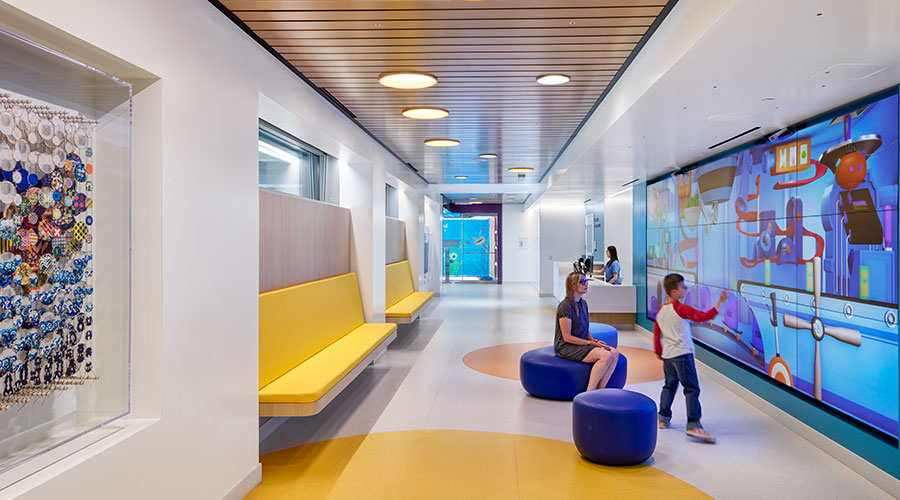The idea of capturing the voice of pediatric patients and families is important when designing and planning facilities for pediatric health. Many pediatric patients cannot advocate for themselves in healthcare settings, so providing a way for the voice of the pediatric patient to be heard can counter this issue. Also, the pediatric population ranges from toddlers to teenagers contained in a varied scale of development, neurodiversity and cultural backgrounds.
Designers and planners should capture input from patients and families to create a tailored approach that responds to the unique needs of the patient population being served and the community at large.
Using engagement tools
When beginning the design and planning process, healthcare institutions can apply different tools to capture the patient and family perspective:
Patient and family advisory council. Forming an advisory council and establishing clear goals upfront can help determine success. Consider including a balance of perspectives, demographic representation, parents, families, age ranges and care type — first-time, frequent and past patients.
Engagement process. Create a framework for engagement to decide the way the advisory council will be structured, meeting frequency, on-site or virtual meetings, makeup of the research and design team, and the decision-making and evaluation process.
Measuring outcomes. Measuring success through a pre- and post-occupancy evaluation can contribute valuable quantitative, critical-to-quality data to confirm that designers have met goals, and it can provide lessons for future planning.
Case studies in design
Several recent pediatric facilities present different approaches to soliciting input from patients and families using targeted research and planning tools.
Gillette Children’s, which specializes in treating brain, bone and movement conditions, is expanding its St. Paul, Minnesota, campus. To envision the renovated space, Gillette consulted with patients and its Gillette Family Advisory Council — a group of parents, adult patients and staff committed to promoting quality, family-centered care — to participate in surveys during programming, planning, master planning and design development to provide feedback on the current clinic and insight for the new space.
As part of the research, families, patients and the Family Advisory Council were invited to open houses to review fully equipped mock-ups and virtual reality walk-throughs. Handheld devices scanned QR codes to capture feedback, while designers, HGA’s diversity and equity leaders and caregivers were available to answer questions. For their time and efforts, participants were offered compensation.
Feedback included: a need for positive distractions that engaged all the senses through light, colors, sound, images and texture that appeal to a broad of ages; improved access for patients with limited mobility; adding comfortable family spaces that accommodate caregivers and siblings; single-use restrooms with adult changing tables; and such utilitarians requests as hooks for winter coats.
Cedars-Sinai Guerin Children’s pediatric inpatient unit offers the full range of specialized care on a renovated plaza-level unit in the Saperstein Critical Care Tower on the main campus in Los Angeles.
The unit features a variety of children- and family-focused amenities, such as a playroom, a game and movie room and a family reception and waiting area with an interactive wall. Parents have quiet areas to work and decompress, while children have a variety of customizable spaces to interact with caregivers, child life specialists and other patients.
Finishes, furniture, colors, lighting and artwork address the needs and sensibilities of diverse conditions and age ranges, from young children to teens and adult visitors. One highlight is a healing garden with artist-designed sculptural frogs and rabbits, a leaf table, patterned walkway surfaces and a canopy of large steel flowers in pastel yellow, green and purple.
The design team led all planning meetings virtually during the pandemic, integrating Cedars-Sinai’s desire for all campus buildings to be sophisticated and modern while still projecting an engaging aesthetic for this specific pediatric population. Staff user-group meetings helped define operational and workflow needs while structured focus groups pulled in the voice of families and patient groups to review design concepts.
Since opening in 2022, the Guerin Children’s has served as a model for future pediatric development systemwide.
Children’s National Hospital in Washington, D.C., is one of the nation’s top-ranked pediatric hospitals. The tight urban site along busy urban cross streets did not allow for a typical canopied entry sequence. In fact, the entry was through an underground garage with confusing wayfinding and low lighting levels.
To understand the journey of patients and families, the hospital and HGA facilitated a multi-method research approach to analyze and map staff, patients and families as they navigated to the entrance, including time and motion studies to identify challenges where families stopped in confusion. The team also surveyed parents and staff about their experiences and even asked children to draw pictures of their ideal experiences.
The data shaped the solution, ultimately improving vehicular and pedestrian wayfinding leading to a brightly lit three-bank elevator lobby with a grand stairway connecting the floors.
By using a range of research tools to engage patients and families in the design process, healthcare institutions can create facilities that capture these voices and reflect their needs while elevating the care experience. While data provides valuable tools for the owner and design team, it is also important to report back to the families and patients to validate their input. For instance, Gillette’s open house mock-ups provided real-time feedback where participants saw the way their ideas were influencing design iterations.
Design teams also need to translate concepts of equity and inclusion into physical spaces. For instance, HGA has been including its in-house equity team in the research and planning process to provide perspectives on the best ways to capture diverse voices and understand cultural differences to further inform planning, inspiring confidence among patients and families as they move through the care journey.
Mezio Zangirolami, AIA, NCARB, LEED AP, is a pediatric planning principal at HGA. Erin Labrec is a medical planner at the firm.

 How Healthcare Facilities Can Be Truly Disaster-Resilient
How Healthcare Facilities Can Be Truly Disaster-Resilient TriasMD Breaks Ground on DISC Surgery Center for San Fernando Valley
TriasMD Breaks Ground on DISC Surgery Center for San Fernando Valley Bigfork Valley Hospital Falls Victim to Data Breach
Bigfork Valley Hospital Falls Victim to Data Breach AI-Driven Facilities: Strategic Planning and Cost Management
AI-Driven Facilities: Strategic Planning and Cost Management  Double Homicide Suspect Hides from Police in Upstate Community Hospital
Double Homicide Suspect Hides from Police in Upstate Community Hospital